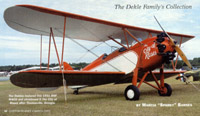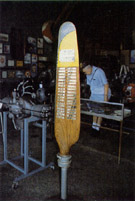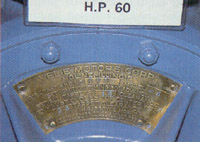
The Dekles restored this 1931 RNF WACO and christened it The City of Roses after Thomasville, Georgia.

Strolling slowly into the old hangar, itself a relic from the days when Thomasville Airport was a World War II military airbase, I noticed a glossy wood propeller blade standing vertically amidst the people meandering through informal rows of radial, in-line, horizontally opposed and Vee-type engines. It was adorned with small brass plaques engraved with names, and while I stood and read James Dekle's poem dedicating this simple yet stately memorial to "airport friends I once knew who from this hallowed field have flown," I could faintly hear the cough of cylinders detonating old 73- or 100-octane gasoline and smell their smoky, pungent belch of oil-and-fuel exhaust.
This humble yet remarkable aircraft engine museum, nestled in the Deep South's City of Roses got its start in the late 1960s when James and John Dekle, a father-and-son team, acquired—almost by happenstance—a 1918 French-built, 10-cylinder radial Anzani.
James Dekle, in his soft native Georgia cadence, describes how a friend of his found the engine, grown over with kudzu vines and bushes, in the swamps down south of Macon, where "bootleggers back during prohibition days had cut a strip on a little ridge and were hauling booze from Brunswick to Macon. After prohibition was repealed, they had no more use for the airplane, so they pushed it back under an oak tree and left it."
He says he "figured if somebody didn't start saving some of those engines, nobody would ever know what they looked like, except for pictures." So Dekle spoke with the swamp owner, and she agreed to give the engine to him. But it took a little work to reclaim it from the swamp's thick overgrowth. Dekle says he "paid a couple of fellows $75 to go out in the woods and get it. They carried a truck with a winch on the front, and took the cable over and tied it to a tree. Then they winched the truck through the mud holes, and finally got over to the engine, where they cut it loose and brought it out."
Dekle and his son, John, painstakingly cleaned the old Anzani, welded a customized rolling stand for it and painted it sparkling jet-black and silver. With the protective and patient smile of a caretaker who's been entrusted with uncommon treasure, Dekle explains that he and John "pulled one jug on it and determined we could make it run if we wanted to, but we decided not to because it was rare. If something happened, and a bolt or nut fell in it and disintegrated it, it's gone forever. And so we decided we'll just display our antique engines; we won't run them."
According to Dekle, the Anzani caught the attention of the Smithsonian in Washington, D.C. "They sent a curator down here two times wanting this engine," said Dekle, who describes the Anzani as his favorite, saying that "If I had to get rid of every engine in here except one, this would be the one I'd keep."
Although the family's collection started decades ago, they began actively acquiring engines and aviation memorabilia during the last eight years. Dekle says, "This is just a hobby and nothing that's going to pay us back, except for the enjoyment of it. I started showing the engines, and more and more people started coming in, wanting to see them."
Visitors to this unique hangar-style museum are able to touch and feel nearly everything in the collection, and, impressed by the display, several of the museum's visitors have offered their own old aircraft engines to the Dekles—often for no more than the cost of coming to retrieve them. Dekle, softly chuckling, remembers when "One man was showing us an old Roberts engine at his house, and he said 'if you care to haul it off, you can have it.' Well, he hadn't even finished saying it when my son, John, had one end of it up on the back of the pickup truck."
That Roberts 4X engine is the oldest of the 46 aircraft engines in their collection, according lo John, who says the two-cycle engine was built in 1910. "It isn't complete, but where do you find parts for a 1910 engine?" John asks.
By 1917 four different types of engines were being built. The radial engine, usually air-cooled, had a fan-type cylinder arrangement. The air- cooled rotary was similar to a radial, except the cylinders revolved around a fixed crankshaft. Two banks of cylinders angled upward from the crankshaft in the air-cooled, Vee-type in-line engine, and cylinders extended upward in a row above the crankshaft in the vertical in-line engine.
Other World War I vintage engines in the museum include a Vee-type in- line water-cooled Curtiss OX-5 used primarily in the Curtiss "Jenny" airplane and several engines built by Charles Lawrance. The 1916 air- cooled 28-hp Lawrance Model A-3, with its two horizontally opposed cylinders, powered the nonflying 1917 Breese Penguin military trainers. Lawrance later designed a three-cylinder and nine-cylinder radial engine. The latter led to the development of the J-5 Wright Whirlwind, after Lawrance's company was absorbed by the Wright Aeronautical Corporation.
Another interesting example is the in-line Taylor engine, which, according to John, was built in 1919 and developed 160 horsepower. John says, "There is very little known of this one-of-a-kind engine. It was the only engine completed by the Taylor Engine Company in Ohio, when the World War I surplus engines, such as the Hisso, OX-5, Hall-Scott and Liberty were dumped on the market. In 1919 Taylor closed its doors. This was an unusual, water-cooled engine due to its light weight, six cylinders, battery distributor ignition and overhead cam."
Along the second row of engines, proudly displayed behind several antique outboard motors, is a French-built, nine-cylinder radial Salmson 9AD. It holds poignant memories for the Dekle family, because it was the prized favorite of James' wife of 52 years, Rheba, who shared her husband and son's love for the old engines up until her death in 2000. This type of Salmson engine powered the Caudron C-109 of 1925, as well as variations of the Daimlcr/Klemm aircraft in the 1920s and '30s.
The Dekles are rather selective and, at times, protective of the engines they collect, according to Dekle, who says, "I don't want any two airplane engines alike, and I'll trade the engines I buy, but I'll never get rid of the engines people give me." So, in addition to receiving donated engines, the Dekles also acquire some of their aircraft engines from car and farm shows.
Neatly displayed on one of the customized mobile engine stands is their Velie M-5, a small five-cylinder radial that developed around 60 horsepower and was built by the Velie Automobile Company of Moline, Illinois. It was primarily used in the two-place Velie Monocoupe, which won closed-course racing and speed events at the 1928 National Air Races in Los Angeles, California.
Sometimes it's relatively easy to find out information about an engine's history, but readily available sources don't always yield helpful details. One such engine is the Dekle's Ford "B" air-cooled conversion engine. Ford built the four-cylinder Model "B" engines during the early 1930s, and John says, "Whoever did the conversion was definitely a first class machinist and mechanic. The engine would date from 1932 and probably develop 40 horsepower. We have a sign posted on it requesting any other information."
Another unusual engine in the Dekle's collection is a radial diesel. According to John, the nine-cylinder, air-cooled Guiberson A-1020 was "made in Houston, Texas, by the Guiberson Oil Well Machinery Co. It weighs 650 pounds and produces 310 horsepower, and can burn diesel fuel, kerosene, heating oil or tractor fuel."
The largest engine in their hangar museum is a Wright Cyclone R-2600, which powered World War II aircraft such as the Grumman Avenger, Curtiss Hell-68 diver and Martin Mariner. A Wright Cyclone R-1300 is also on display, along with a Continental R-975-46. According to John, the latter was a "Wright-design license, built by Continental, and was a World War II engine. Boosted to 525 horsepower, it was used in some training planes and, following the war, in many crop dusting planes. It was a nine-cylinder engine and first began life as a 300-hp 1929 Wright J-6-9."
Other engines on display include a 145-hp Warner Super Scarab, a Franklin 4AC 150-A and the well-known Continental A-40, A-50 and A- 65 models. A 12-cylinder, 450-hp Franklin 0-805-2 was built for use on a prototype, radio-controlled military aircraft near the end of World War II, but the program was cancelled before the aircraft were built. This large Franklin engine has horizontally opposed cylinders, and John, careful to restore it as closely as possible to original, hand painted the bright red Franklin logo on each of the rocker box covers.
Nestled in among the aircraft engines are bookshelves and display cases, revealing a treasure trove of memorabilia, and the corrugated-metal hangar walls are covered with aviation-related advertising, signs such as "Wings Cigarettes," "Drink Solo Cola," "Your Thirst Takes Wings," and "White Flyer Laundry Soap Makes Dirt Fly." Early model radios and an assortment of coffee mugs with aviation emblems line bookcase shelves, while Tailspin Tommy comic books, Gosport systems and a miniature handcrafted model of a Travel Air biplane are tucked away in a glass case.
When the Aircraft Engine Museum doors aren't open, the Dekles round up the iron steeds and hustle them to the edges of the hangar to make room for two antique biplanes. The miniature biplane already mentioned was modeled after NC4952, a 1928 Curtiss Wright Travel Air 2000 powered by a 220-hp Continental 670-6N.
The Dekles spent four and a half years restoring the aircraft, and just about every member of the family had a hand in the restoration process, including James, John, Rheba and sister, Janice Gay, and grandfather, J.B. Dekle. The result of their joint labor is the handsome red-trimmed, royal blue biplane that, "the lead plane in a three-plane formation towing a huge banner over Miami, Florida. It was also used for passenger hopping and finally served as a crop duster before we restored it to its original configuration."
Its hangar mate is NC11237, a 1931 RNF WACO powered by a 145-hp Warner Super Scarab. The Dekles, after a 20-year search for an affordable antique biplane, ended up finding the aircraft "stored in a dairy barn 26 miles from Thomasville, Georgia. It only took one year for our family to restore it," says John, adding, "It was used as a barnstormer when new and for many years thereafter."
The gorgeous red and cream WACO, christened The City of Roses after its namesake (the city of Thomasville), has been flying for 40 years since its restoration in the early 1960s.
The Dekles normally acquire an average of four "new" engines every year, according to John, who explains, "This is truly a labor of love. We're saving the engines before they all disappear into scrap heaps. Some of our engines were literally retrieved from scrap yards and restored as much as possible to original condition."
Their "labor of love" is clearly visible to museum visitors by the quality of the engines and memorabilia displayed, and a small sign on a brass pedestal in the front of the hangar states their mission simply: "Welcome to the Dekle Collection of Old Aircraft Engines. The primary purpose of this museum is to assemble the best possible 'hands-on' display of the history of early and wartime aero engines. There is no charge to view, examine, take photos or ask questions. Donations to help with future acquisitions and/or restorations will be appreciated. If you wish to donate or loan an old engine, it will be given the best care I can afford."
Dekle's eloquent poetry, which randomly punctuates the museum's displays, portrays the essence of his passion for the preservation of aviation's past and future. The following excerpt from one of his poems, "When the Fly-In is Over," says it best:
"Well, the last hurrah is over
The last stake pulled from the
ground,
All the airplanes have departed
Aloft and homeward bound.
I
stand and gaze into the distance
Quietly wipe away a tear.
Will there be a
new tomorrow,
Will I last another year?
The snarl of a big round
motor
As it struggles to be free,
As silence flees to the far side of the
field
And hides behind a tree.
It's kind of sad to say 'so long'
To
friends we love so dear -
And if the Lord be willing,
We'll see y'all
again next year..."
The Dekle family's Aircraft Engine Museum is, as James Dekle says with his warm down-home Georgia smile, "open anytime anybody calls me." It's also traditionally open during the annual Thomasville fly-in, held during the middle of October.


The centerpiece of the museum is this
memorial propeller, dedicated to departed airport friends. It shares the honor
with a two cylinder Lawrance A-3 engine in the background. The 28-hp Lawrance
powered the Breese Penguin, a nonflyable World War I trainer.

This is the data plate on the 1928
60-hp Velie M-5 engine, manufactured by the Velie Automobile Company of Moline,
Illinois.

The Dekles spent four and a half years
restoring this 1928 Travel Air 2000. This aircraft and the WACO share the hangar
space with the family's aircraft engine collection.